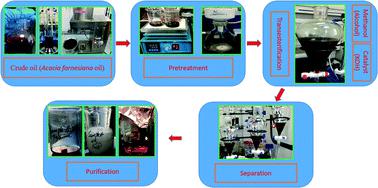Our official English website, www.x-mol.net, welcomes your
feedback! (Note: you will need to create a separate account there.)
Non-edible plant seeds of Acacia farnesiana as a new and effective source for biofuel production
RSC Advances ( IF 3.9 ) Pub Date : 2022-08-02 , DOI: 10.1039/d2ra03406a Inam Ullah Khan 1 , Abdul Haleem 1, 2 , Assad Ullah Khan 3
RSC Advances ( IF 3.9 ) Pub Date : 2022-08-02 , DOI: 10.1039/d2ra03406a Inam Ullah Khan 1 , Abdul Haleem 1, 2 , Assad Ullah Khan 3
Affiliation

|
Currently, the energy crisis is a hot topic for researchers because we are facing serious problems due to overpopulation and natural energy sources are vanishing day-by-day. To overcome the energy crisis, biofuel production from non-edible plant seeds is the best solution for the present era. In the present study, we select the non-edible seeds of Acacia farnesiana for biofuel production from different areas of Pakistan with better oil production results. Different kinds of analytical method, like the American Standard for Testing and Materials and techniques like Fourier transform infra-red spectroscopy, nuclear magnetic resonance spectroscopy, gas chromatography, and inductively coupled plasma optical emission spectrometry, were used to evaluate the chemical compositions. The maximum oil extraction rate (23%) was produced by petroleum ether. Potassium hydroxide exhibited the best conversion result of 96% fatty acid methyl ester. The transesterification method was used for the preparation of fatty acid methyl ester (96%) using potassium hydroxide and methanol. The viscosity and density of Acacia farnesiana seed oil biodiesel was comparable to American Standard for Testing Material biodiesel standards. By using gas chromatography-mass spectrometry, five fatty acids were detected comprising palmitic acid (6.85%), stearic acid (2.36%), oleic acid (12.13%), linoleic acid (46.85%), and α-linolenic acid (1.23%). This study concludes that Acacia farnesiana seed oil biodiesel could be an intriguing raw material for yielding Acacia farnesiana seed oil methyl ester as an alternative fuel source.
中文翻译:

金合欢非食用植物种子作为生物燃料生产的新有效来源
目前,能源危机是研究人员的热门话题,因为我们面临着人口过剩和自然能源日益消失的严重问题。为了克服能源危机,利用非食用植物种子生产生物燃料是当今时代的最佳解决方案。在本研究中,我们选择了金合欢的非食用种子用于来自巴基斯坦不同地区的生物燃料生产,石油生产效果更好。采用美国材料与试验标准等不同的分析方法和傅里叶变换红外光谱法、核磁共振光谱法、气相色谱法和电感耦合等离子体发射光谱法等技术对化学成分进行评价。石油醚产生的石油提取率最高(23%)。氢氧化钾表现出最佳的96%脂肪酸甲酯的转化结果。酯交换法用于使用氢氧化钾和甲醇制备脂肪酸甲酯(96%)。金合欢的粘度和密度种子油生物柴油与美国测试材料标准生物柴油标准相当。气相色谱-质谱法检测出五种脂肪酸,分别为棕榈酸(6.85%)、硬脂酸(2.36%)、油酸(12.13%)、亚油酸(46.85%)和α-亚麻酸(1.23%) )。本研究得出结论,金合欢籽油生物柴油可能是一种有趣的原料,可用于生产金合欢籽油甲酯作为替代燃料来源。
更新日期:2022-08-02
中文翻译:

金合欢非食用植物种子作为生物燃料生产的新有效来源
目前,能源危机是研究人员的热门话题,因为我们面临着人口过剩和自然能源日益消失的严重问题。为了克服能源危机,利用非食用植物种子生产生物燃料是当今时代的最佳解决方案。在本研究中,我们选择了金合欢的非食用种子用于来自巴基斯坦不同地区的生物燃料生产,石油生产效果更好。采用美国材料与试验标准等不同的分析方法和傅里叶变换红外光谱法、核磁共振光谱法、气相色谱法和电感耦合等离子体发射光谱法等技术对化学成分进行评价。石油醚产生的石油提取率最高(23%)。氢氧化钾表现出最佳的96%脂肪酸甲酯的转化结果。酯交换法用于使用氢氧化钾和甲醇制备脂肪酸甲酯(96%)。金合欢的粘度和密度种子油生物柴油与美国测试材料标准生物柴油标准相当。气相色谱-质谱法检测出五种脂肪酸,分别为棕榈酸(6.85%)、硬脂酸(2.36%)、油酸(12.13%)、亚油酸(46.85%)和α-亚麻酸(1.23%) )。本研究得出结论,金合欢籽油生物柴油可能是一种有趣的原料,可用于生产金合欢籽油甲酯作为替代燃料来源。











































 京公网安备 11010802027423号
京公网安备 11010802027423号